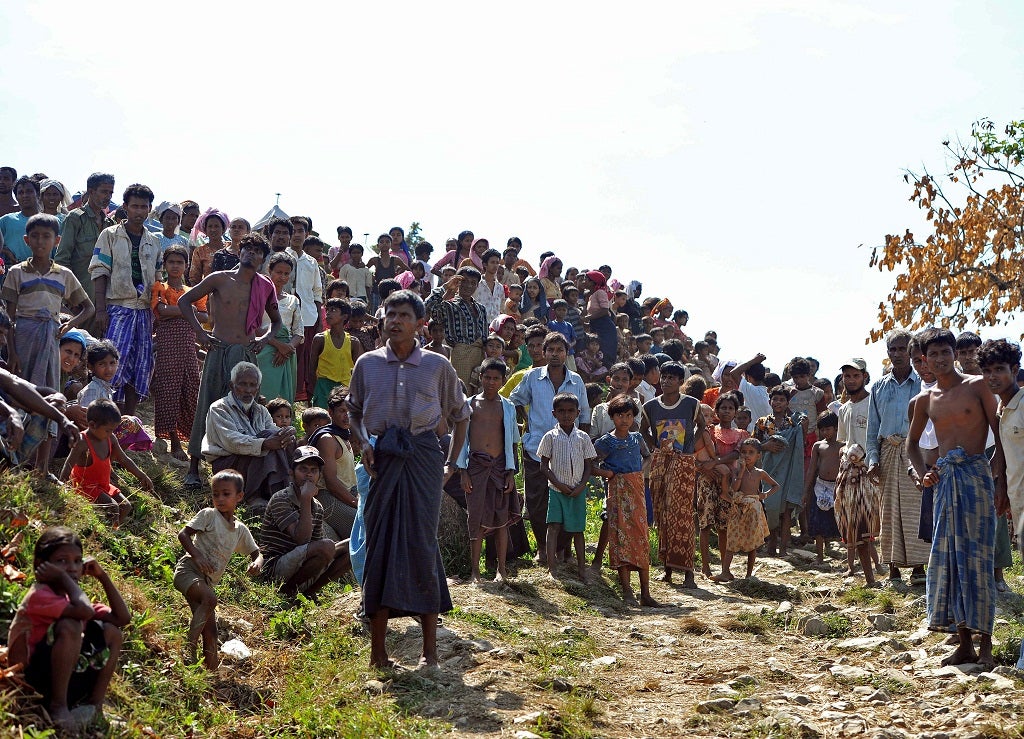Obama is set to visit Burma - but will he help the tormented Rohingya people?
Evidence is mounting that attacks on the Rohingya are not just skirmishes but an organised pogrom

Your support helps us to tell the story
From reproductive rights to climate change to Big Tech, The Independent is on the ground when the story is developing. Whether it's investigating the financials of Elon Musk's pro-Trump PAC or producing our latest documentary, 'The A Word', which shines a light on the American women fighting for reproductive rights, we know how important it is to parse out the facts from the messaging.
At such a critical moment in US history, we need reporters on the ground. Your donation allows us to keep sending journalists to speak to both sides of the story.
The Independent is trusted by Americans across the entire political spectrum. And unlike many other quality news outlets, we choose not to lock Americans out of our reporting and analysis with paywalls. We believe quality journalism should be available to everyone, paid for by those who can afford it.
Your support makes all the difference.“Please treat us like human beings” the sign reads. It is one of several placards held up by the emaciated inhabitants of a refugee camp in Rakhine state, Burma, captured in a photograph taken by locals.
It can hardly be said to be an unreasonable plea. Sadly, it may be a hopeless one-for those making the appeal- the Rohingya people of Burma- are not treated like human beings. Instead, they are a stateless minority, suffering from the continual threat of racist violence from their neighbours. This year 100,000 or more have been driven from their homes by mob attacks, which destroyed entire villages and neighbourhoods.
Sources within Burma have sent a plethora of photos, pixellated phone videos, and messages to me this week, desperate to share visible records of their suffering. The refugee camp protest photo is certainly among the least upsetting files I’ve received. Some appear to show the victims of ethnic violence in June; others appear to be from last month’s equally bloody riots. They are, for the most part, harrowing and gruesome: shots of dead babies; corpses putrefying on beaches; young people shot in the groin or stomach; purported torture victims. Such horrors, I am told, are the result of intentional pogroms - not mere “ethnic skirmishes” as some have portrayed events.
Police attacks
In addition to visual evidence, I have received compelling witness testimony. One source from Sittwe told me that he had clearly observed police involvement in some of this year’s violence. He stated that a group of thousands of Rakhine “including police, security forces” had surrounded the Rohingya area in June and that “everybody [in the mob] had a sword, some had weapons, some guns.” He saw that houses were subjected to arson attacks, after which time the occupants fled their homes only to be attacked by the crowd. “Rakhine started killing us, our people tried to protect [themselves]…at that time police shot us.”
Such claims of systematic, discriminatory violence are supported by independent analysis. Andrew Heyn, Britain’s ambassador to Burma told Radio 4 recently that “there’s compelling evidence, that this latest wave of attacks [against the Rohingya]...were pre-planned, coordinated and organised.”
Adding to the case for high-level involvement, a Reuters investigation released this weekend quoted senior political sources as stating that the recent attacks against Rohingya were “led by Rakhine nationalists tied to a powerful political party in the state, incited by Buddhist monks, and… abetted at times by local security forces.”
It’s clear that the Rohingya have also been the target of hostility from a large number of Buddhist monks, who are influential among the population. Yet one prominent Buddhist figure has spoken out, arguing that political forces are seeking to stir up inter-communal animosities for their own gain. Ashin Gambhira, a monk who was heavily involved in 2007’s brutally suppressed Saffron revolution, wrote recently: “the neo-military dictatorship has exploited and fostered a new national crisis, a religious conflict, the Rakhine-Rohingya conflict, for its own purposes… These clashes were encouraged by the military.”
This is ethnic cleansing
American human rights advocate Dr. Nora Rowley, drawing on her experience of working in Burma, told me that the attacks on the Rohingya were “absolutely” being backed by members of the former military junta, now incorporated into the political elite. She suggested “what we need right now is to connect the regime with what’s going on so the international community know it’s not an internal matter.”
I asked her what she believes will happen if nothing is done to protect the victims. “Ethnic cleansing completion,” was her terse reply.
The recent news that Barack Obama is set to visit Burma’s President Thein Sein in coming days has been the source of some hope to those that imagine he may seek to press Burma on the plight of the Rohingya. Yet there is room for pessimism: American business interests in the country are strong, as are geo-political concerns - Burma sits between two regional powers, India and China, and Washington will be mindful of the importance of gaining a stronger foothold in the strategically-positioned country. As a result, Obama may not push too hard on an issue that is domestically controversial in order to advance other agendas.
However, as I have argued before, the safety of the imperiled Rohingya people is an issue of major concern to those who value the rights of threatened minorities - and the shame will belong to all of us if the world fails to prevent an entirely predictable humanitarian catastrophe in the near future. More has to be done.
Join our commenting forum
Join thought-provoking conversations, follow other Independent readers and see their replies
Comments